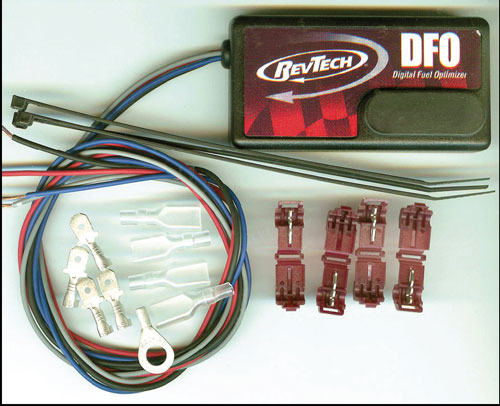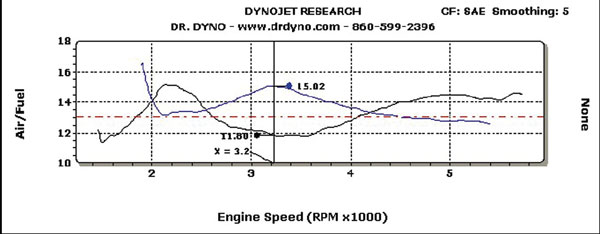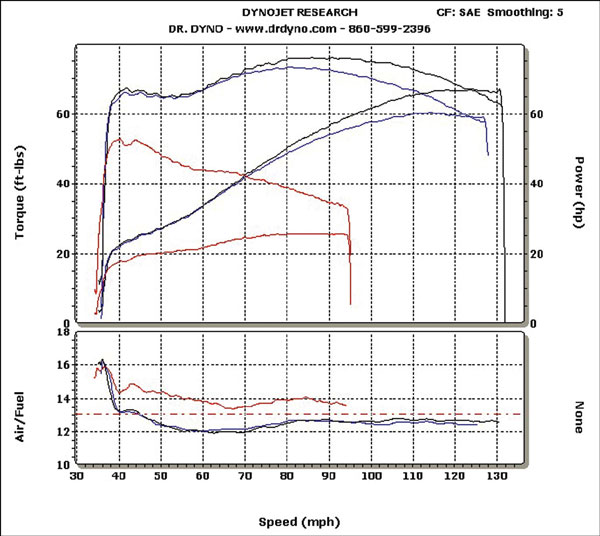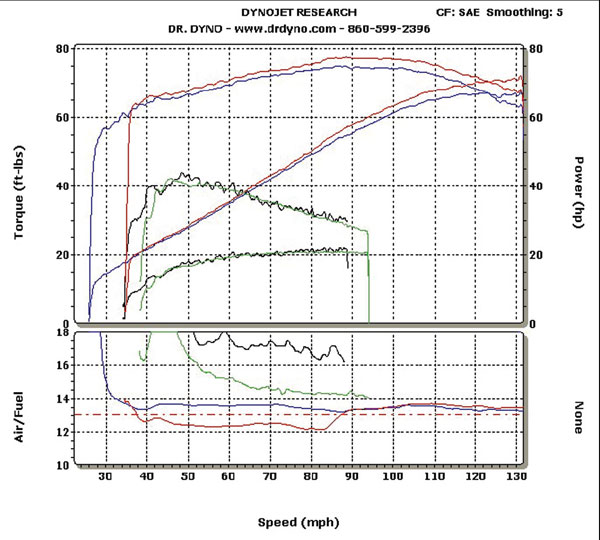How It Works by Dr. Dyno, American Iron Magazine, August 2006
Dyno Dos And Don’ts, IV
Electronic fuel injection tuning options
“CAN YOU TUNE MY BIKE’S FUEL INJECTION by doing a download or something?” “If I put a Power Commander on my bike, will it make more power, get better mileage, run better, get rid of the popping, etc.?” These are just some of the questions I answer every day at my mobile dyno. The correct answers are: no, maybe, possibly, maybe, probably, and it depends on what “et cetera” means. How about this one: Just the other day, I was tuning a bike equipped with a Power Commander for a guy who said, “My friend had the dealer put a Race Fueler on his (racing) Harley and he went up 9 hp, from 60 to 69!”
My customer may have been initially thinking (and foolishly hoping) that I could do the same thing for him and add nine ponies to the 76 hp we’ve already gotten by tuning his race bike. I’ve actually had guys tell me that they had both a Race Tuner and a Power Commander on their Harleys. Expecting additional power increases from using components like this is like thinking that Stage I plus Stage II equals Stage III. That’s just not how it works, guys. These devices are not electronic superchargers, so they don’t add power like that. The only way that using both a Race Tuner and a Power Commander will “stack” for you, as they say in diesel pickup circles, is in the Franklins you’ll spend buying both systems. After all, we all know what H-D really stands for, don’t we? Hundreds of dollars, right? In fact, the 9 hp previously mentioned didn’t come from the Race Fueler; it was due to the high-flow air cleaner and freer-flowing exhaust system that were installed at the same time.
TUNING FACTS
This time around, we’re going to discuss five add-on modules and programmers for Harley-Davidson Evo and Twin Cam fuel injection systems. An add-on is a device that is used in conjunction with the bike’s original computer or ECU (electronic control unit). These are pot-style (as in potentiometer, not that other stuff ) devices, while a Power Commander, Screamin’ Eagle Race Tuner, and Direct Link modules, which we’ll cover next month, are map-type devices. We’ll need to get a little technical discussing both types, but we’ll hopefully take some of the mystery out of fuel injection, with the result being a practical understanding of all covered systems.The available EFI tuning devices also fall into the hardware (parts) or software (numbers) categories, with some being combinations of both. One option we don’t have for Harleys is a chip, which is an actual piece of hardware with an integrated circuit memory that plugs into the computer’s circuit board. When you have this as an option, as you do on cars and trucks, the stock chip is swapped out for a “hot” one. Since we can’t physically access the internal circuit board of a Harley ECU, we can’t “chip” it.
Whatever the method, the goal is to get the desired air/fuel mixture into the combustion chamber for burning. Two (or more!) devices add up, or stack, only in the sense that the final mixture will be the sum result of the output of each device. As for the engine, it doesn’t care how many electronic hands the data passes through or how much you handed over to buy them. It just wants the right fuel/air mixture so it can burn it.
As previously discussed in Dyno Dos And Don’ts II, the engine needs an air/fuel mixture ratio of about 13:1 (13 parts air to one part fuel) for maximum accelerating power. It needs a leaner ratio, around 14.5 to 15.0:1 for cruising, with 14.7:1 being the optimum for the most complete combustion and lowest emissions. Going richer than 12:1 doesn’t make any more power; it just wastes fuel. However, that extra fuel cools the engine, which is more than can be said for going the other way, like cruising with a 16:1 mixture. But contrary to what you may think, this ratio doesn’t save fuel; it wastes it because the engine’s power output is down so low that it takes a lot more throttle to maintain cruising speed. However, the worse result is an engine that’s running excessively hot, which is certainly not good for its longevity.
 This DFO unit from Custom Chrome is another add-on, pot-style EFI unit that only allows you to change the system’s fuel settings. |
CONSISTENCY
An understanding of manufacturing consistency will go a long way toward explaining why someone else gets good results with a tuning setup that may not work quite as well on your bike, even if you install the same modifications.Take the sportbike manufacturers, who are in a continual race to see which brand will wear the horsepower crown (and sell the most bikes) each year. In the late 1980s, Suzuki made history by flirting with the magic number 100 with its GSXR-750. Today, a 600 that doesn’t hit 100 hp is practically a lemon. These engines are truly state of the art, but what’s even more amazing is their consistency. When I started testing GSXR- 1000s in 2001, the first half dozen were within less than 1 percent of 143 hp. How is it possible to produce such tight tolerances on complex machines and then mass produce them for under $10,000? I can only guess, but the fact is that the competition in the sportbike marketplace demands it. You could practically use one to calibrate your dyno. Of course, an inertia dyno doesn’t need periodic calibration, but the point here is that the consistency in manufacturing leads to bike-to-bike consistency in the maps that a company like Dynojet, for example, develops for its sportbike Power Commanders.
As for Harley-Davidson, who isn’t selling horsepower, the company has no reason to control production tolerances to the extremes we see from the sportbike manufacturers. Most completely stock Twin Cams dyno out close to 60 hp with torque in the mid-70s. But don’t be surprised if your Harley makes a few horsepower more or less and low to high 70s for torque. A 5 percent variation (up or down), for a total of 10 percent, which is probably due in part to differences in cam timing and compression, is to be expected. So why wouldn’t we expect a similar deviation in air/fuel ratios from one Harley to another? Honestly, I did not plan it this way, but the two bikes with stock cams that I chose as examples for this article show very close to a 5 percent richer (12.35) and 5 percent leaner (13.65) ratio than our normal 13:1 air/fuel target. Taking it one step further, what about the maps the Motor Company itself develops for its own upgrade kits. They often end up being anything but the calibrations H-D calls them.
ADD-ON ADJUSTERS
Let’s take a look at some of the most commonly used tuning devices and their capabilities. We’ll then dyno some bikes and see what they need.In the hardware category are those addon tuning devices that externally modify the bike’s ECU output signals. These units stay on the bike to perform their duties. Harley’s Screamin’ Eagle Race Fueler and Dobeck Performance’s TFI, Custom Chrome’s DFO, and Küryakyn’s Wild Things FI Controller are of the potentiometer or “pot” design. With these, you use a small screwdriver to turn the pots to adjust the rpm and mixture settings. Electrically, they control the injectors and, by holding them open longer, richen the fuel/air mixture. (According to the 2006 catalog, the Fueler can also lean the mixture on 2005 models.)
All units are linear or load-based, meaning they add less additional fuel at low throttle openings than they allow at full throttle. These are fuel-only devices so, by “adjust the rpm,” I don’t mean you change the rev limiter settings; they can’t do that. Rather, you are selecting transition points — two for the Race Fueler — to break the rpm band into, while the others all have one, three, or two ranges, respectively. Then you adjust the mixture pots to richen the air/fuel ratio across those rpm bands. While the Fueler, with its two rpm pots to the other’s one, might seem to offer more flexibility at first glance, the mid-to-high rpm pot’s minimum setting is 4500 rpm, so you end up with one transition rpm for the whole riding range, effectively the same as the rest of the units. Deceleration (decel) popping, which doesn’t hurt the bike, but sure can be annoying, can often be reduced or eliminated, but I’m not making any promises.
At this point, let me at least mention the new Vance & Hines Fuelpak. This is an add-on hardware device that connects in series at the ECU. You adjust it by entering numbers into 18 “modes,” using the buttons and the digital display on the unit. First, you get the set of numbers for your particular model and year bike, exhaust system, and ECU stage from Vance & Hines. You then load the numbers in yourself and feel like a “genius,” according to the V&Hvideo, because you set up your bike’s fuel injection system yourself. Vance & Hines’ official position when I contacted them about writing this article is that they haven’t released the “tuning kit” yet and are doing all the program development in-house. That makes it somewhat of a mystery box, at least as of this writing, but presumably the kit will explain the modes in terms of rpm and throttle opening, so a bike could be tuned on a dyno in a logical fashion.
Like the others mentioned, the Fuelpak is a fuel-only device without the ability to increase the rev limiter, but unlike them the Fuelpak can also decrease, as well as increase, fuel delivery. Although that’s important, especially when we start changing cams on race Harleys, I can’t say at this point whether the Fuelpak will have the range or resolution to cover most hop-up builds. That’s because, in my experience, direct-component-match canned programs often come up well short of perfection on individual bikes due to the abovementioned bike-to-bike 10 percent variation, which is outside the aftermarket programmers’ control. The best they can do is “shoot for the middle,” which ends up working great on the “middle” bikes and not so well on the rest.
DIAGNOSIS BEFORE PRESCRIPTION
So the first question really is how do you know if you need anything? Let’s take a common and effective upgrade. In my experience, every Evo or Twin Cam intended for racing benefits from replacing the stock air box and filter with a highflow assembly. The gain in horsepower is about 10 percent in real numbers; that’s with no soft baseline tricks on the dyno, as described in last month’s Dyno Dos And Don’ts III. However, the torque gain is the most important improvement, to my way of thinking, because torque is what you feel. Normally, a stock bike’s torque has peaked by 70 mph and is on its way down. In fact, just when you could use a little more, the engine is starting to lay down on you. With a high-flow air cleaner, the torque is not only higher at 70 mph, but it’s still climbing, typically until 90 mph. So, to get back to the first thing to ask, if you install a high-flow air cleaner, do you also need the Stage 1 download to “give it more fuel because you’re giving it more air”? About half of the bikes I’ve tested do need the fuel/air mixture richened, and it doesn’t seem to matter whether they’ve had the H-D download installed or not.
The only way to really know for sure if you need to mess with the fuel settings is an air/fuel test on a dyno. (Keep in mind that a Model 150 Dynojet only reads horsepower and torque. You must use a 200 or 250 Dynojet to get an air/fuel reading.) In fact, I recommend three dyno tests, as I’ll illustrate with the graphs of Jack’s bike, a stock 2006 Ultra Classic. Note that in all the examples, I’ve expanded the air/fuel graphs for easier reading, and that up is leaner and down is richer.
The first test is the normal dyno test, which is a set of three to five full throttle runs to establish the true baseline (blue lines) for air/fuel ratio, horsepower, and torque. The air/fuel ratio should start off on the rich side and lean out some as the ECU senses the engine warming up. (That’s not illustrated here, since I’m showing only the third run.) The second test (black lines) is done with the air cleaner cover and filter element removed, which is giving the engine all the air it wants. Both runs show the air/fuel ratio curve on the safe (rich) side of the 13:1 target line. The jump in torque and horsepower (peak 67, up from 60) shows what a high-flow air cleaner would do. But, before we simply bolt on a new cleaner, we need one more check: a partial-throttle cruise test.
I’m sure guys with a Model 250 dyno can simulate a cruise with a percentage load test, but I like another test better. My dyno buddy, Lloyd Greer (www.Lloydz.com), came up with it. On a Model 200 (or a 250 in inertia mode), give the bike partial throttle at about 40 mph in fifth gear and run it up to 80-90 mph. It may take a few tries, but you’re looking to make about 20 to 25 hp at about 65 to 70 mph. That’s the power it takes to cruise at those speeds. Then check the air/fuel ratio at the same speeds. Jack’s bike also ran safely below 14:1 at cruise (red lines), so he’d definitely have no worries with just a high-flow air cleaner.
 Here are the air/fuel curves at full throttle for the two bikes we’ll be looking at next month. One’s a 2002 Heritage and the other, a 2003 Ultra Classic. Think about what the torque curves must look like and how you’d use a pot-type add-on to correct the air/fuel curves. |
Mike’s 2005 Road King racer is a different story. It came onto the dyno with a high-flow air cleaner already installed, but with no Stage I download. We know that for sure because it hit the stock rev limiter at 5600 rpm; the download moves it to 6200 rpm. The baseline test (third run, blue lines) looked just okay air/fuel-wise, but the peak horsepower was right on at 67. As for the cruise test (black lines), they were not good at all. In fact, they were very lean! So, he obviously needed the Stage I download, right? Not necessarily. I’ve seen many bikes this lean that I’m sure had the download because they revved past the stock limiter. After installing a TFI, I even had to adjust the full throttle mixture a little richer than 13:1 just to get cruise (green lines) under 15:1.
These graphs also illustrate another important point about how a pot-type tuner operates. With the transition pot set at 3700 rpm (85 mph in fifth), the device simply moves the air/fuel line down (from blue to red) without changing its shape. We’ll see how important that becomes when we take a look at cammed bikes next month.
CONCLUSION
Many owners like programmers because there are no “extra boxes” on the bike. Others prefer an add-on device that can be disconnected and removed without a trace. Like high-flow air cleaners, they can often be transferred to your next bike. A programmer permanently locks itself to the first ECU it is used on. I like the add-ons because, in general, they get the job done just as well with less time and frustration. Obviously, we didn’t cover all the units that are available, but you should now have a much better idea as to how to match other devices’ capabilities to your bike’s needs. Remember, if you don’t do your homework and just ask a seller if his product is right for your bike, his answer will be “Yes!”My favorite add-ons for stockcammed bikes is the TFI, DFO, or FI, with two qualifications. The first is, does the bike even need a richer air/fuel mixture? I’ve taken these units off bikes that were rich enough without them. The second is, do you need to move the rev limiter up? Personally, I hit the limiter, moved or not, in all the lower gears most of the time. But many guys rarely hit even the stock limiter, and, therefore, the fact that pot-type add-on can’t change the rev limiter’s setting doesn’t matter.
The Race Fueler is a close second. It’s also a relatively small box, and, like the others, easy to tuck in many places under the seat. The only drawback’s the 4500-rpm minimum transition on the mid-to-high pot. With a customer’s bike (with a Fueler already installed) on the dyno, what I don’t like to say is, “If I could only set it a little lower, I could get your bike perfect.”
Another point to consider is what your future plans for your ride are. You might guess that cams are going to change the picture, and you’d be right. So I’ll show you now the air/fuel curves at full throttle for the two bikes we’ll be looking at next month. One’s a 2002 Heritage and the other, a 2003 Ultra Classic. Think about what the torque curves must look like and how you’d use a pot-type add-on to correct the air/fuel curves. Hints: Keep in mind that you get to pick an rpm transition point with the TFI, DFO, and FI and can richen the mixture separately above and below that rpm. If you decide to use the Fueler, you get two rpm transitions, creating three rpm ranges that you can richen separately.
Maybe we’ll need a Power Commander, Screamin’ Eagle Race Tuner, or Direct Link to get the job done. We’ll see next month, but be ready for a little surprise on the bike that already goes rich in the midrange. AIM
Editor’s Note: After working as an Electronic research and design engineer for the U.S. Department of Defense in New London, Connecticut, for 22 years, Dr. Dyno, aka Fred Eno, retired and sometime later bought his own dyno. After several years of testing and tuning Harleys, he formed Eno Enterprises LLC in 2000 and conferred on himself the title Dr. Dyno (www.DrDyno.com). I have spent a lot of time with Fred in the dyno room and can attest to the fact that he knows his business. — Chris


